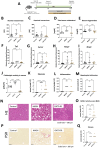Chitinase-1 inhibition attenuates metabolic dysregulation and restores homeostasis in MASH animal models
- PMID: 40510344
- PMCID: PMC12158736
- DOI: 10.3389/fimmu.2025.1544973
Chitinase-1 inhibition attenuates metabolic dysregulation and restores homeostasis in MASH animal models
Erratum in
-
Correction: Chitinase-1 inhibition attenuates metabolic dysregulation and restores homeostasis in MASH animal models.Front Immunol. 2025 Aug 15;16:1680129. doi: 10.3389/fimmu.2025.1680129. eCollection 2025. Front Immunol. 2025. PMID: 40895523 Free PMC article.
Abstract
Background: OATD-01 is a chitinase-1 (CHIT1) inhibitor, reducing inflammation and fibrosis in animal models where chronic inflammation leads to tissue remodeling. CHIT1, predominantly secreted by macrophages, is overexpressed in metabolic dysfunction-associated steatohepatitis (MASH).
Methods and results: In the study, we demonstrated the therapeutic efficacy of OATD-01 in two murine models (STAM, DIAMOND) and one rat model (CDHFD) of MASH. RNA-Seq analysis of livers obtained from CDHFD rat model revealed that OATD-01 reversed MASH-dysregulated genes. In addition to reducing inflammation and fibrosis observed in the rat model, RNA-Seq demonstrated that OATD-01 regulated key metabolic processes such as acetyl-CoA metabolism, triglyceride metabolism, cholesterol synthesis, cholesterol flux, and glycolysis. Using functional assay performed on bone marrow-derived macrophages (BMDMs) we demonstrated that both genetic and pharmacological inactivation of CHIT1 resulted in inhibition of glucose uptake. As a consequence, our data suggest decreased glycolysis, accompanied by increased ATP levels, lower citrate, and increased acetate levels, ultimately leading to a reduced IL-1β secretion in BMDMs.
Conclusions: These results revealed the key role for CHIT1 in regulating metabolism. OATD-01 is a macrophage modulator that can directly restore metabolic balance and consequently inhibit inflammation and fibrosis, supporting its use for MASH treatment.
Keywords: MASH; OATD-01; chitinase 1; fibrosis; glycolysis; inflammation; macrophage; metabolism.
Copyright © 2025 Drzewicka, Głuchowska, Mlącki, Hofman, Tuszyńska, Ryan, Piwowar, Wilczyński, Dymkowska, Grzybowski, Dymek, Rejczak, Lisiecki, Gołębiowski, Jagielski, Muchowicz, Ryan, Zabłocki, O’Neill and Zasłona.
Conflict of interest statement
Authors KD, KG, MM, BH, IT, KP, MG, BD, TR, KL, AG, AM, and ZZ were employed by the company Molecure S.A. Author LO'N was a scientific advisor for the company Molecure S.A. The remaining authors declare that the research was conducted in the absence of any commercial or financial relationships that could be construed as a potential conflict of interest.
Figures







Similar articles
-
Chitinase 1: a novel therapeutic target in metabolic dysfunction-associated steatohepatitis.Front Immunol. 2024 Sep 23;15:1444100. doi: 10.3389/fimmu.2024.1444100. eCollection 2024. Front Immunol. 2024. PMID: 39381000 Free PMC article.
-
BMDM-derived ORP8 suppresses lipotoxicity and inflammation by relieving endoplasmic reticulum stress in mice with MASH.Mol Med. 2025 May 30;31(1):213. doi: 10.1186/s10020-025-01275-6. Mol Med. 2025. PMID: 40448016 Free PMC article.
-
Inhibition of ATGL alleviates MASH via impaired PPARα signalling that favours hydrophilic bile acid composition in mice.J Hepatol. 2025 Apr;82(4):658-675. doi: 10.1016/j.jhep.2024.09.037. Epub 2024 Sep 30. J Hepatol. 2025. PMID: 39357546
-
How improvements in US FDA regulatory process and procedures led to the drug approval for first ever treatment of a common liver disease.Acta Pharmacol Sin. 2025 Mar;46(3):515-524. doi: 10.1038/s41401-024-01396-4. Epub 2024 Nov 7. Acta Pharmacol Sin. 2025. PMID: 39511464 Review.
-
TREM2 in MASH: integrating lipid metabolism and immune response.Front Immunol. 2025 Jun 25;16:1604837. doi: 10.3389/fimmu.2025.1604837. eCollection 2025. Front Immunol. 2025. PMID: 40636122 Free PMC article. Review.
References
MeSH terms
Substances
LinkOut - more resources
Full Text Sources
Medical
Research Materials
Miscellaneous

